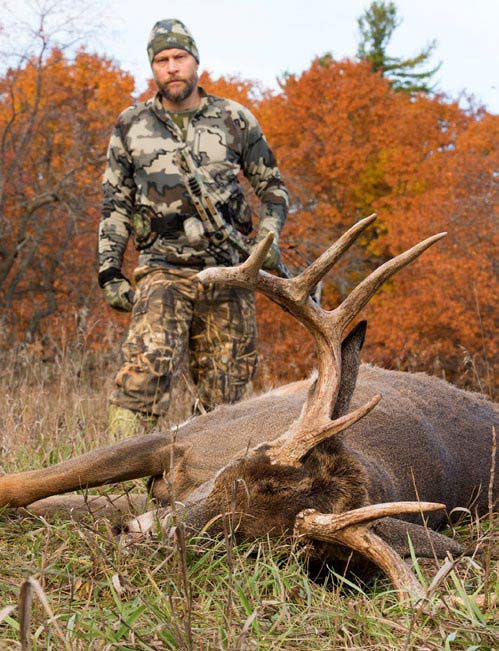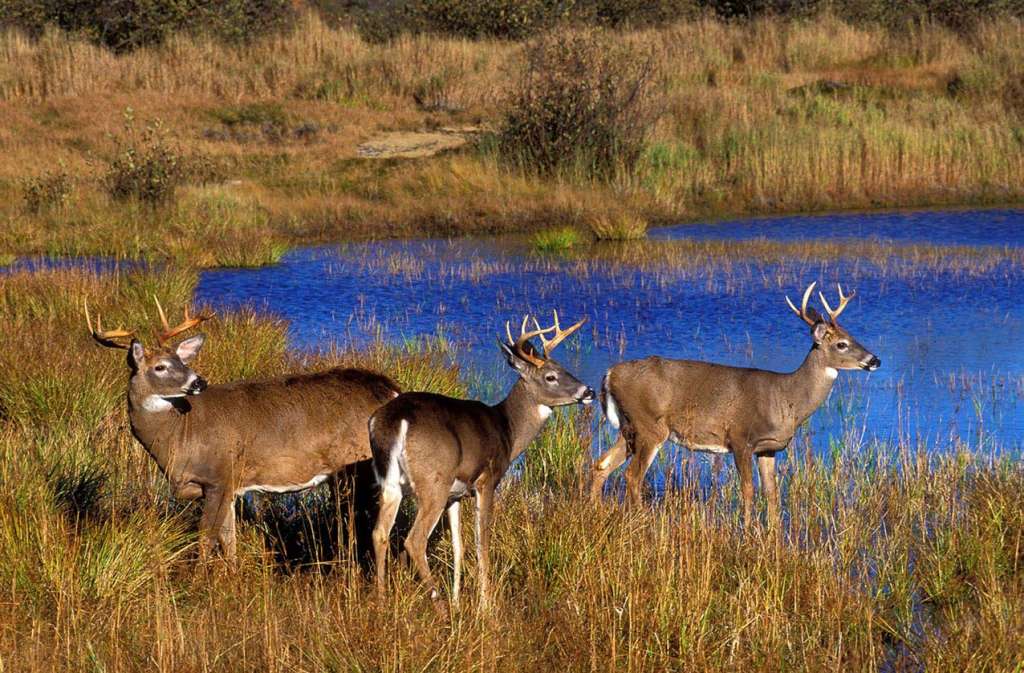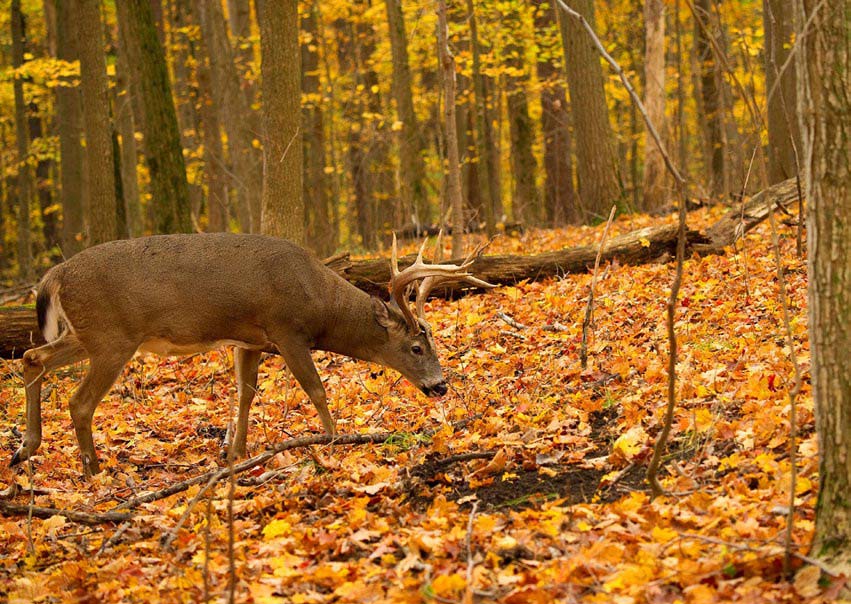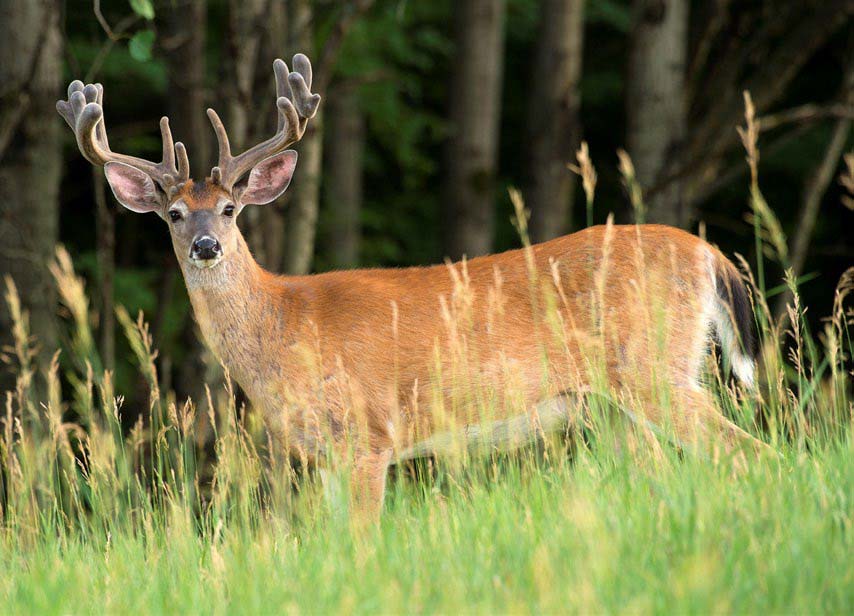The concept of patterning Whitetails is not new. Our grandfathers did it naturally as they were afield farming or logging. They observed bucks as they went about their workdays, making mental notes of where and when the Whitetails appeared. For those who farm today and who hunt on their own property, this is still the status quo. But for hunters who live in cities or who hunt on a piece of land that isn’t close to home, a concerted effort must be made to go afield and learn about or scout for the deer that inhabit the area.
Most of us look forward to time spent scouting for deer sign. It allows us to spend hours walking the woods, identifying deer trails, rub and scrape hot spots, finding last year’s antlers, and even spotting the deer themselves. Ultimately, scouting and deciphering how the deer live where you hunt pays off. It helps you decide where to invest your hunting energy by significantly increasing your chances of harvesting a Whitetail in the fall.
For most of the year, deer follow fairly predictable patterns of movement. The only exception is the few weeks of rutting, typically through November. Trying to pattern or predict deer movement during this time is virtually impossible—especially for the bucks. The closest thing to pegging Whitetails in the rut is to locate the heart of a buck’s home range, set up watch, and wait for him to return, or to pinpoint where a doe group is living.
Scouting October Fields
To find a buck’s core range, scout the woods and field edges in October. Picture a landing strip at the airport with the row of lights illuminating the runway. Then, watch the trees for rubs, which are one of the most visible cues that a buck is in the neighborhood. But how long ago was the rub made? Will the buck return? If so, when? If the bark is hanging off in strands and the rub has a fresh appearance as opposed to looking like it’s been sun-dried for a year, that indicates it would have been made within the past month. But will the buck return to that rub? Don’t bet on it.
Keep in mind, if you find several fresh rubs on trees within sight of each other, you’ve found one of the best places to hunt during the rut. These blaze the buck’s path of travel and show the “runway” that he’s been using. You can even tell the direction that he was traveling by looking at the rubs. Bucks will always rub the side of the tree that they approach. With this in mind, it should be fairly apparent where to set up. My choice would be a ground blind or tree stand about 30 yards downwind from the trail.
When you find this gold mine, you’ll likely notice several places where the ground has been torn up. Bucks will make many scrapes during October. Scrapes, like rubs, will be in the highest concentration near the center of the buck’s home range, where the animal spends the majority of its time. Finding three to four scrapes within 50 yards is another sure indicator that you’ve found the right place.
Homing in on these signposts is the best way to pattern a Whitetail buck during the rut, because whenever he is not already occupied with a receptive doe, he’ll revisit this location. The buck will return to make a new rub or two, and likely freshen a couple of the scrapes, leaving new deposits of his scent to reinforce his dominance in the area. He’ll also check around for any does that may have caught wind of his appealing odor and could be lingering be in the area.
Compared to the explosive mating season, Whitetails can be quite predictable throughout the rest of the year. When armed with the familiarity of the terrain where you hunt, and by knowing which foods attract deer (something that changes through the seasons), you can learn to predict the movement patterns of Whitetails with surprising accuracy.
Observing Year Around
For many hunters, Whitetail season isn’t simply a fall affair. It’s a pursuit they enjoy year-round through scouting and observation. Successful scouting can allow a hunter to predict where a deer or a group of deer will be at any given time. This is not to say that these predictions are foolproof, but an educated guess is certainly better than an uneducated one, especially when it comes to the elusive Whitetail. For hunters who prefer to pursue the biggest bucks, pre-season scouting is the best way to find out where the wall-hangers live, as well as planting plots and using the best deer attractants.
For me, scouting and patterning Whitetails is a hobby that allows me to feel like I’m hunting all year. Winter and summer are the easiest seasons to predict deer movement. In northern climates, food becomes scarce during the winter months, resulting in deer yarding in lowlying stands of conifer. I make it a point to know where the deer yard is on my hunting land, but I still minimize the disturbance in this sanctuary.
Winter yards are easily recognized when found. They’re crisscrossed with deer trails and groups of beds, found partially melted in the snow under the sheltering boughs of pine or cedar trees. A third indicator of a wintering area is an abundance of deer droppings.
Once they are located, you should stay away from the yarding area so as not to cause any unnecessary disturbance. The coldest season is also the most challenging for northern Whitetails. With limited inferior forage, they need to conserve energy and minimize weight loss to remain in the best physical shape possible.
Signs of Spring
Early spring is one of the best times to scout and learn about the deer where we hunt. The time between when the snow melts and before the forests turn green again is the best time to view deer sign. Not only is all of last autumn’s buck sign still evident for viewing, but the opportunity to find the shed antlers provides one of the best indicators of the size and age of the bucks inhabiting the area. By finding the previous autumn’s rubs, you’ll learn where the bucks concentrated their energy during the rut. This is very useful for predicting where the buck activity will be for the coming fall.
Deer trails are also easy to see in early spring since the vegetation has yet to grow over them. Keep in mind that animals always travel the route of least resistance. This can help us to understand why the deer choose certain paths to walk from their bedding to feeding areas. Knowing this makes it possible for us to have some influence on where their runways form.
In one section of the land where I hunt is an old wire farm fence. It is located about 30 yards back in the woods and it’s no longer in use. This fence had influenced the route the deer chose as they wound through the woods toward the field where they fed. Originally, the deer crossed the fence at two spots about 40 yards apart where it had slackened about two feet, making it easier to clear.
A few springs back I took a pair of wire cutters and cut down a four-foot section of the fence in the middle of the two crossings. Now, the deer funnel through the one opening, creating a single, well-used trail towards the field instead of two separate paths. I’ve now harvested mature bucks from there during fall hunts.
Follow the Water
Water is another potential deer magnet to watch for while scouting. Make note of where the creeks or woodland watering holes are located. If there are only one or two water sources in the area, they may be great spots to hunt. Check the edges of the pond or creek. If the soil is exposed, deer tracks should be obvious along the bank, if they use it. There may be a small stretch of the creek where they prefer to drink. If you hike along the creek while watching the edge, you may see a favorite drinking site. I have found the highest concentration of deer activity at water to be near cover, often where a trail crosses a stream or near a bedding area. Watch for a dense patch of pine or cedar, or a sizable dogwood thicket. If the creek wanders close to such a spot, you could be in luck.
“The Whitetail’s preferred foods (agricultural crops and fresh wild greenery, such as wild grape), typically remain the same through July and August. As the calendar flips to September, feeding habits change radically.”
Summer Cover
As the forests become engulfed in vegetation in late May and June, deer become less visible as they take advantage of all the new food within the forest. By mid-July, they should be visible again in the fields during the first and last hour of daylight.
For the remainder of the summer, it’s likely that deer will emerge to feed in relatively the same location day after day. It may be a favorite clover or alfalfa field, a hydro-line cut, or a forest opening where the trees have been logged in recent years.
One of the best parts of summer scouting is watching the buck’s antler growth. The biggest bucks can grow up to half an inch of new antler per day, especially through late June to early July. A week between sightings can make a big difference in their appearance.
The Whitetail’s preferred foods (agricultural crops and fresh wild greenery, such as wild grape), typically remain the same through July and August. As the calendar flips to September, feeding habits change radically. This is especially true in areas that are not surrounded by agriculture (alfalfa, corn, or other crops can still attract deer through the fall).
One summer while I was conducting a research study for the government on Whitetail deer movement patterns and distribution, I became very familiar with the routines of individual deer. There is one buck that I’ll always remember. He was a perfect-looking 10-pointer that would have easily scored 160 Boone and Crockett. Every morning for almost a month, he crossed a forest access road at 7:00 a.m. sharp. He was rarely off by even five minutes. At the end of August, he broke this pattern, and I didn’t spot him again for two weeks. Eventually, I found him and the reason why he’d switched it up. He was about half a mile away, feeding from a couple of old abandoned apple trees— his new preferred food.
Autumn Magnets

Before the rut starts, a Whitetail’s primary feeding activity still occurs in the morning and evening. Midmornings through late afternoons are typically spent bedded, chewing their cud. They will get up a couple of times during that day to snack, drink, and reposition themselves. Calm midday can be the perfect time for an ambush by an old oak in the woods.
Bedding areas stay fairly localized throughout most of the year. I have found most beds to be under or adjacent to stands of evergreens, and in the densest low-lying thickets in or at the end of fields or swamps. The last two are especially true for big bucks. These areas can be so thick that it’s impossible to sneak through without the buck hearing you long before you get near him. I’m talking about the kind of dense growth that’s guaranteed to knock the hat off your head or whip that unexpected twig in your eye—causing that instant, irrepressible comment to be uttered just above your breath—but loud enough for that buck to hear.
Cold, Drizzly Days of Fall
The colder days of late fall cause deer to be attracted to the warming sun and to bed on south-facing slopes in the forest.
It’s important to locate where favorite Whitetail food sources are during the fall months but keep scouting to a minimum at this time of year. If bucks are routinely spooked from an area or if they smell concentrations of human odor in any given area, they will change their activity patterns or go nocturnal. Aside from one or two hikes through your hunting area, steer clear for the couple weeks before hunting season. Leave that reconnaissance to your trail cams.
Since most of the rubs and scrapes won’t be made until most bow seasons are open, the best strategy to find where bucks are hanging out is to do so while still hunting.
My favorite early-season days to scout and still hunt are drizzly, damp days when the normally dry, crunchy forest leaves become wet and silent. These are also the days that deer won’t expect to encounter humans in the outdoors, and they’re more likely to be moving as well.
Hunters who shoot big bucks year after year know the land that they hunt as well as the nooks and crannies of their own home. Through scouting, they learn the deer activity patterns throughout the year and develop a familiarity with the prey that can’t be matched by any other means. Being aware of the deer that live on your hunting land and where they meet their daily needs will enable you to better predict their movement patterns and significantly elevate your odds of success.
By Mark Raycroft
(photos © Mark Raycroft)
Per our affiliate disclosure, we may earn revenue from the products available on this page. To learn more about how we test gear, click here.










